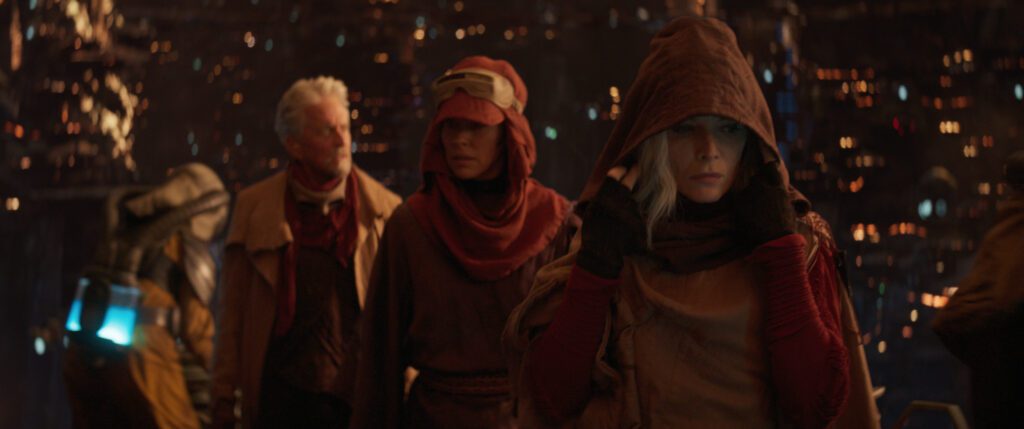Discussing the Marvel cinematic universe has become a dull exercise. Said discussions are now dwarfed by “Marvel Fatigue” as the main talking point and to be fair, it is a self-inflicted wound for the MCU. You successfully pull off a Hail Mary of interlocking films with overarching stories released over the course of 15 years and audience expectations will swing from actually enjoying the films to waiting for you to pull the Hail Mary off a second time. But however one may feel, Any discussion specifically about Ant-Man and the Wasp: Quantumania, and its role in the greater MCU canon and how it plays in service of it, falls away thanks to its many filmmaking faults. It’s been a while since this franchise has produced an instalment this weak.

Former-convict-turned-Avenger Scott Lang (played by Paul Rudd) is enjoying the post-Endgame life. He’s got a book deal, baristas give him free coffee and his relationship with Hope van Dyne aka Wasp (Evangeline Lilly) is borderline perfect. However, that relationship is a stark contrast to the one Scott has with his teenage daughter Cassie (Kathryn Newton). Along with Hope’s parents, Hank (Michael Douglas) and Janet (Michelle Pfeiffer) – the latter of whom did her best not to talk about her experience being trapped in the subatomic quantum realm for decades – the Langs and Van Dynes do try their best to be a loving and supportive family.
But after one of Cassie’s scientific experiments goes wrong, the family finds itself scattered across the quantum realm, much to Janet’s horror. They quickly discover the realm is teaming not just with life but forces that threaten life itself, taking the form of the intimidating Kang the Conqueror (Jonathan Majors). Luckily, there’s an Avenger on the scene and it’s up to Ant-Man to save the day and reunite everyone and save the realm.

The headline of Quantumania is that it has the worst dialogue ever spoken in an MCU movie. It is the result of a screenplay that goes against the traditional Marvel formula by prioritising plot over character. The film exists in the canon as Kang’s introduction and while Kang is worthy of such attention, it’s offset by characters either delivering exposition as a non-stop matter of fact or vocalising emotions that we already know them to be experiencing.
It’s a fatal blow to a sub-franchise whose character likability and human aspect have always been its strongest draw card. Director Peyton Reed is on record saying Quantumania wouldn’t be another “palette cleanser” for MCU audiences and that’s fair enough. But this is a subversion of audience expectations that doesn’t work in the filmmaker’s favour and again, the script is doing nobody any favours.

Except for Kang. The film’s saving grace is a villain that outshines the heroes (a rare phenomenon for MCU instalments). Jonathan Majors is taking no prisoners and while his delivery may come off stunted at times, there’s no denying his presence on screen with it made clear that this is a man Ant-Man has absolutely no business facing. While this writer is concerned about how Marvel will deploy Kang in future movies (as a concept, Kang is vulnerable to comedy if mishandled), it’s a strong start for an antagonist that is charismatic as he is sinister. And while sharp criticism can be laid against this film, it must be full credit and respect for successfully manifesting a character as ridiculous and “comic book-ey” as M.O.D.O.K, a genetically-engineered man-cyborg that serves as Kang’s killing machine. M.O.D.O.K. steals any scene that he’s in and Kang isn’t. It is a legitimate pleasure to see Marvel taking more absurd storytelling and visually-challenging swings like him.

As mentioned, Kang is outshining the heroes and that’s a shame. Rudd continues to be a very likeable frontman and enjoys good chemistry with Lily, Douglas and Pfeifer. Newcomer Kathryn Newton, to whom the film’s overarching emotional beat belongs, is along with Pfeiffer saddled with the bad dialogue and as such, her relationship with her father does receive the build-up and tension required for the later payoff. However, She’s perfectly fine as is the rest of the cast and reflects the attitude of the next generation of young, Marvel heroes who we are now able to catalogue across the franchise. Bill Murray is also in this film, but his appearance is as much an afterthought as this sentence.
As is the case with M.O.D.O.K., Quantumania is swinging for the fences with its visuals. But with the bar set high thanks to Black Panther: Wakanda Forever and Thor: Love and Thunder who exhibit strong cinematography and creative world-building and execution, the quantum realm comes off as…standard. Travelling through the MCU, locations festooned with similar-looking assets were bound to become the norm. But the realm remains uninspired and as much as it pains me to say it, Christophe Beck’s musical score doesn’t uplift the atmosphere as it did in the previous Ant-Man films.

One cannot help but suspect that Quantumania is only half the film that Reed wanted to make, with the other half being Kang’s amplified introduction and the film’s obligation to kickstart the next phase of the MCU. The positive elements from the first two films are still there but they are buried under failed storytelling and characterisation. It’s a shame. Ant-Man 3 wanted to be larger than life. Instead, it shrinks in the shadow of greater, aggressive goals.
Ant-Man and the Wasp: Quantumania is now in South African cinemas.
Photo courtesy of Marvel Studios. © 2022 MARVEL.
Also by Sam Spiller: Avatar: The Way of Water sticks to the surface of a shimmering ocean

